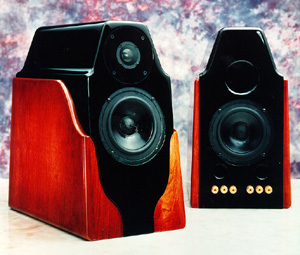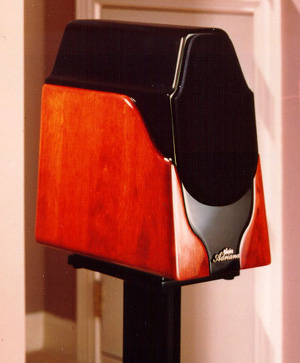

September / October, 1997
Alón Adriana
Loudspeakers
Moving on Up to the Big
Sound
By Myles B. Astor
BREAKING THE SMALL SPEAKER STEREOTYPE
 Well, to quote Bob Dylan, "The times, they are a-changin'." The Alón
Adriana speakers are the forerunners of a new breed of ultimate
mini-monitors combining visually stunning aesthetics with
state-of-the-art sound. These small speakers are sonically
competitive with their bigger brethren!
Well, to quote Bob Dylan, "The times, they are a-changin'." The Alón
Adriana speakers are the forerunners of a new breed of ultimate
mini-monitors combining visually stunning aesthetics with
state-of-the-art sound. These small speakers are sonically
competitive with their bigger brethren!
The Adrianas are very special speakers, a breath of fresh air when compared to the polite, slow, boxy, muffled and bass-shy sound of older mini-monitors. When combined with top-notch electronics and front ends, the Adrianas' low-level resolution, especially at low listening levels, is bested only by the finest electrostatic speakers such as the Martin-Logan reQuests. And the resemblance between the two speakers doesn't end there. Both speaker types are extremely revealing of the upstream components. Tonally, the Adrianas' overall musical balance is closer to the Martin Logan reQuests than to the richer-sounding Magnepan MG20s. In short, this is a speaker to build an ultimate system around.
Take Martin Simpson and Wu Man's recording Music for the Motherless Child (WLA-CS-49-CD). This release is to Bela Fleck's Tabula Ras (WLA-CS-44-CD) what Tabula Ras was to earlier Water Lilly recordings. According to Kavi Alexander, owner and recording engineer on these recordings, the only difference between the current and previous Water Lilly CDs are the use of gold alloy instead of a gold disc. (Tim de Paravicini is currently designing a new record cutting lathe for Water Lilly's forthcoming vinyl releases.)
Music for the Motherless Child is the first CD that adequately captures the harmonics of the guitar (and Simpson's steel-bodied National) and the pipa (a Chinese instrument similar to an oud). Through the Adrianas, Simpson's guitar is rich, clean and vibrant sounding. Low-level harmonic information abounds. Plucked strings have a clean, incisive, leading edge without the hangover or boxiness typical of small-box speakers. The Adrianas' whisper-quiet background-noise levels allow them to accurately convey the music's dynamic accents. Even a recording's weaknesses- for example, the loss of instrumental dimensionality- is immediately apparent.
POWER IS NO OBSTACLE
When it comes to choosing an amplifier for the Adrianas, quality wins out over quantity. Small-wattage, single-ended amplifiers like the 9-watt Cary 300SE drove the speakers effortlessly - certainly exciting news for SE fans. This is in contrast to the reQuests and especially the MG20 speakers, which require big, powerful and good-sounding amplifiers. Carl Marchisotto isn't certain why his speakers work so well with single-ended amplifiers, because the Adrianas aren't particularly sensitive or a flat load. He reckons that part of the secret is that single-ended amplifiers (with poor damping factors) find it easier to drive the Adrianas' ultra-lightweight and small drivers.
All I know is that the Cary was the best sounding single-ended amplifier that I've heard in my system. The amplifier's 9 watts belied its dynamic capabilities and loudness levels. Transparency (especially considering it was an SE amplifier) and midrange smoothness were particularly good. The frequency extremes were not quite up to the standards set by the midrange, and the amplifier needs a bit more resolution and neutrality to elevate it to ultimate status. Still, one could not leave without being impressed by this combo. But the real take-home message was how the Adrianas revealed the differences between my reference conrad-johnson Premier 12 and the Luxman M7 and Cary amplifiers!
OVERCOMING THE ACHILLES' HEEL OF SMALL SPEAKERS
 Tonally, the Adrianas are exceptionally well balanced, maybe even
shockingly so for those accustomed to older mini-monitors. The
Adrianas had none of the thinness, brightness or veiling exhibited by
many small speakers. In my room, the speaker easily reached 40 Hz or
so. Now, this speaker won't move air like a big
driver/multi-driver/subwoofer unit, but there is enough low-frequency
extension to balance out the rest of the musical spectrum. And the
bass is fast, detailed and linear. For example on Sarah McLachlan's
The Freedom Sessions (Arista 07822-18784-2), the Adrianas
capture the depth of the bass guitar but don't quite reproduce all of
its pressure or growl.
Tonally, the Adrianas are exceptionally well balanced, maybe even
shockingly so for those accustomed to older mini-monitors. The
Adrianas had none of the thinness, brightness or veiling exhibited by
many small speakers. In my room, the speaker easily reached 40 Hz or
so. Now, this speaker won't move air like a big
driver/multi-driver/subwoofer unit, but there is enough low-frequency
extension to balance out the rest of the musical spectrum. And the
bass is fast, detailed and linear. For example on Sarah McLachlan's
The Freedom Sessions (Arista 07822-18784-2), the Adrianas
capture the depth of the bass guitar but don't quite reproduce all of
its pressure or growl.
The Adrianas' low-frequency speed, detail and clarity really shine though on Oscar Peterson's West Side Story (DCC LPZ2021). Here the speakers' unboxy sound (and freedom from smearing) allows them to capture the leading edge of the bass transients and the cushion of air surrounding the bass. Despite lacking a touch of weight and richness, the Adrianas provide a clear glimpse "inside" Ray Brown's double bass. There is also a small area in the midbass where the speakers lose a touch of articulation. This recording also shows off the speakers' clarity and quickness in the midrange frequencies, a quality cherished by electrostatic fanatics. You never feel like you're listening to a box speaker because of the lack of added resonances and port colorations. The speakers' transparency gives you the feeling that Peterson is putting on a special concert in your living room. There is a slight loss of weight to the piano, like the reQuests, which lightens the piano's tonal color.
THE SECRET TO THE BIG SOUND
So many speaker reviews neglect the subject of speaker distortion levels. Sure, many speakers can play loud- but what are the accompanying distortion levels? In many cases this distortion, which leads very quickly to listener fatigue, stems from dynamic compression in the upper midrange. This is where, in my opinion, David Wilson and the WATT/Puppies made their biggest contribution to box-speaker design. The WATT/Puppies were the first speaker system that could play loud without appreciable distortion. In the case of the Adrianas, there are vanishing low levels of distortion as the playing levels increase. In real world terms, female voices such as Sarah McLachlan, show lower levels of sibilance and hardness than on other speakers.
The New World recording Pulse: Music For Percussion and Strings (New World 319) is an excellent gauge of the Adrianas' dynamic range. When everything is just right, the opening passage of "Pulse" should make you jump. The Adrianas don't disappoint. Dynamic gradations, as exemplified by the difference in sound between the wood blocks and Korean dragon mantles, are rendered with the same aplomb as macrodynamics.
High frequencies are extended and detailed with the conrad-johnson amplifiers; with the Carys, the upper octaves are a bit softer. The Adrianas are capable of real upper-octave dynamic impact and ability to go from one dynamic step to another without feeling like the speaker is gathering itself up before jumping. The dipolar tweeter proves its mettle on "Pulse" by resolving the subtlest details of percussion instruments. Again, this shows the resolving ability of this speaker. No, the tweeter is not quite as resolving, dynamic or extended as the Maggie ribbon-but what driver is?
IMPROVING THE GOLD STANDARD
Finally, the Adrianas improve upon what small speakers are already renowned for- soundstaging and imaging. It's apparent that this soundstaging is a result of the speakers' low-speaker cabinet resonance and diffractive properties. Where the Adrianas set new standards is in their ability to recreate image height. No longer does the image height stop at the top of the speaker! This allows the Adrianas to reproduce the spaciousness as well as the sense of overhead boundaries on the Fourth Movement of Rachmaninoff's Symphony #13 (EMI 3911).
Another recording that shows off the Adrianas' incredible imaging abilities is the Cardas direct-to-disc recording of Kip Dobler in Reaching Out from the Inside (Cardas Records CRS813). The perspective is a studio recording. A seamless soundstage begins behind the speakers, allowing the Adrianas to completely disappear. In contrast, the musicians are much closer up with the Maggies and between the two extremes with the reQuests. The transparency and ambience of the recording wraps around each instrument and envelops the recording venue. Instruments possess a real sense of three-dimensionality while floating in space. Be very careful with this recording, because very small differences in VTA have profound effects upon the midrange palpability and presence- again emphasizing the speaker's resolving power.
THE ULTIMATE MINI-MONITOR
Audiophiles no longer need to apologize for or feel guilty about owning mini-monitor speakers. In addition to being visually appealing, the Adrianas are a real breakthrough for not only mini-monitor speakers but speakers in general. The Adrianas aren't especially fussy about amplifier power and excel in the areas of neutrality, resolution, soundstaging and speed. These speakers make a beautiful addition to any ultimate system or living room.
Alón Adriana, Acarian Systems, Hunters Run, Suite 104, 181 Smithtown Blvd., Nesconset, NY 11767. Tel.: (516) 265-9577. Designers: Carl and Marilyn Marchisotto / Cabinet Designer: Umberto Adrian. Frequency response: 35 to 25,000 Hz +/- 3 db. Sensitivity: 87 db. Impedance: Nom. 8 ohms/Min. 4 ohms. Crossover point: 3,000 Hz. Size: 15 inches high x 8 inches wide x 12 inches deep. Price: $10,000
|
CABINET CONSTRUCTION: The Adriana enclosure consists of an inner MDF (medium density fiberboard) cabinet treated with two layers of extensional damping pads (a plastic-like material) and braced with steel combined with an outer, elegantly finished, solid cherry wood cabinet. Internally mounted screws secure the inner to outer cabinet. Two small rear firing ports extend the speaker's low frequency response. The ports are built into the rear of the speaker to avoid interference with the front-firing waveform. Marchisotto built and tuned the ported enclosure to equal the damping and clarity of a sealed enclosure - and avoid one-note bass quality. In addition, the ported design allows the Adrianas to integrate into and produce high-quality bass in small listening rooms. DRIVER COMPLEMENT: The Adrianas incorporate the Phalanx's extraordinarily neutral, 2-inch, aluminum dome, double-ring Alnico tweeter. Since the driver's back-wave from drivers can never be totally absorbed, Marchisotto chose to run the Alnico tweeter, using the built-in waveguide, as a dipole from 3,000 to 25,000 Hz. This circumvents problems such as distortion, listener fatigue and driver non-linearities. Two, 5¼-inch Phalanx drivers handle the low frequencies. Two layers of plasticizer make these trilaminate cones lighter, better damped and stiffer than polypropylene cones or better damped than metal cones. Front and rear firing bass drivers avoid the phase problems and the spreading out of waveforms that plague multiple, forward firing driver designs. This layout also reduces speaker resonances by cancelling out the driver's back-wave, low-frequency vibrations. As a result. The Adriana operates as a bipole up to 125 Hz.This configuration minimizes musical confusion and maximizes clarity. CROSSOVER AND TRI-WIRING: Early on, Marchisotto decided that the Adrianas were going to be the finest mini-monitors in the world. To accomplish this task, the Adrianas use a linear-phase, 6 db/octave crossover. The crossover (and speaker sound) were further refined by tri-wiring, which prevents circulation of currents between drivers. (Since the impedance never reaches zero, some back EMF remains in the crossover and manifests itself as grittiness, graininess, harshness or a lack of bass bloom) Three internally mounted crossovers and three sets of binding posts electrically isolate each driver and crossover. The only common connection is at the amplifier end of the circuit.
|